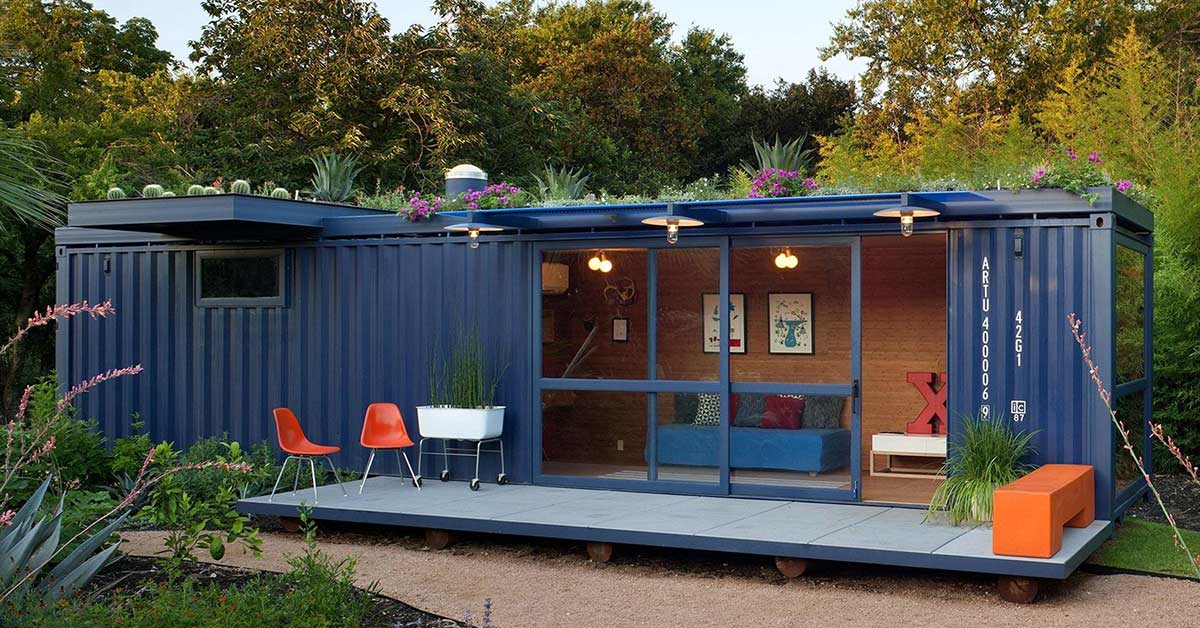With the prices of living soaring across the world, people are finding tons of different ways to live sustainably. Some of these sustainable living trends include living in RVs, trailers, and tiny homes. One of the newer and more popular trends includes, believe it or not, living in a shipping container home.
Reusing shipping containers as homes has become wildly popular in the last few years. Their convenient size and shape make them a perfect alternative to a modern home. You can order single shipping container rooms, or get more than one and stack them together to make full-sized houses.
On average, shipping containers go for around $2000 (1400-2800) for a 20ft container. If you’re looking for something bigger, 40ft containers usually go between $3500-$4500 [1]. It may seem somewhat steep at first, but when you see the type of house you can make with them, you’ll be looking up the closest shipping container retailer near you. Here are some examples of houses made with shipping containers:
What to Know Before You Build A Shipping Container Home
Now that you’ve seen some of the beautiful homes that can be made with shipping containers, I’m going to tell you 10 important things you should know before making one.
Choosing The Right Size
You may find it difficult sourcing the right-sized shipping container for you since there are only two standard sizes:
- 20 feet long with 8-foot width and 8 foot, 6inch height
- 40 feet long with 8-foot width and 8 foot, 6-inch height.
However, there are still a variety of non-standardized shipping containers on the market as well. Some of the dimensions that make up these non-standard sizes include:
- extra-long 45-foot containers
- high cube containers that are a foot taller than the standard size
- pallet-wide containers which have an internal width of 8 feet, and cut-down containers which can be reduced to any length.
See The Shipping Container Before You Buy It
Most shipping containers are purchased online today. While this is convenient, it also comes with its downsides. Many shipping-container-home owners often regret not taking a look at their containers before purchasing, as they can sometimes be in worse shape than they are advertised.
Just ask Larry Wade, the owner of this shipping container home. “The one thing that I wished I had not done was buy my containers without seeing them – I took the company’s word that they would be in good shape,” Wade says. “They were beat all to heck.”
Get Familiar With The Laws About Shipping Container Homes
Every state, province, and country has its own individual set of rules and regulations for shipping container homes. The need for building permits often only applies to larger, multi-piece shipping container homes.
If you don’t want to go through the process of applying for a building permit and waiting on permission from your city council then opt for a single, 20-foot shipping container. Due to their size, they are not considered a “building”, however, you will find that they offer a surprising amount of indoor space, especially if you choose to get a pallet-wide container.
Think About The Wind
This is an issue that many shipping container-home-owners do not consider until it’s too late, and that is the noise that is generated by the wind on a shipping container. The best way to reduce the wind around your shipping container is by planting vegetation around it.
The best vegetation are dense evergreen trees and shrubs as these offer the most protection from the wind. They should be planted close together near the north or northwest end of your home. These natural windbreakers not only offer protection from the sound that the wind generates, but they will also help keep it warm during especially windy days.
Insulating your shipping container home
For shipping containers, blanket insulation is the optimal choice in terms of price and DIY friendliness. Although you will have to insert stud walls to place the insulation in (which may take a few inches off of your living space), once you have them in the fitted insulation can be placed in these gaps easily and quickly.
If you want insulation that takes up less space, go for spray foam insulation. This can be applied to both the interior and exterior of your shipping container, although it is more expensive and requires more work.
There you have it! This is the basic information you need to know before making a shipping container home. Let us know if this information was helpful to you in the comment section.
Keep Reading: Round Houses of Raw Earth: 3D Printing Sustainable Homes in 200 Hours
Sources
- “The Cost of Building a Shipping Container Home.” Target Box. No Date.

